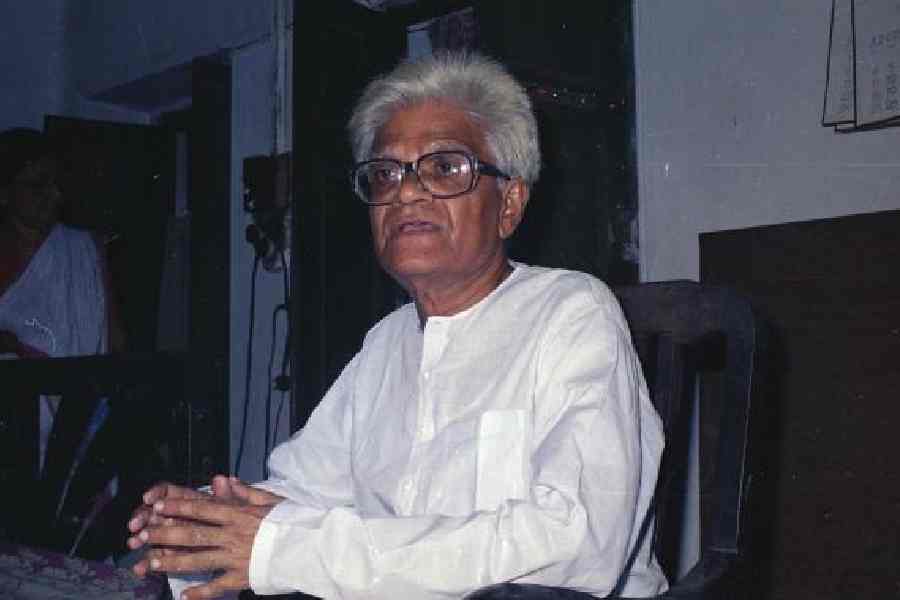One hundred years ago, a gifted teacher of physics was born. He taught concepts of intricate General Relativity (GR) to his students using simple daily life examples. He was Amal Kumar Raychaudhuri, popularly known as AKR in academic circles. A conference celebrating his centenary was organised at the Institute of Mathematical Sciences, Chennai, between October 5 and 7. Experts in relativity from all over India presented talks about the work of AKR, which revolutionised the understanding of the core nature of gravitation.
Newton’s theory of gravitation is about two bodies attracting each other and the lighter body moving towards the heavier one. Einstein’s theory of gravitation is about bodies following a straight line in a curved space-time. This predicted the existence of black holes, which is a stage of stellar evolution.
When a massive star collapses into a tiny volume with super high density, it creates a powerful gravitational field from which even light cannot escape. Hence the name “black hole”. In black holes, there is a point of singularity where all laws of physics would break down. Modern science is unable to predict what happens at singularity.
“The equation AKR discovered, apart from being the basis for the proofs of the singularity theorems of (Stephen) Hawking and (Roger) Penrose, is a basic and fundamental statement in physics and mathematics. It has been and is being used in diverse areas of physics and mathematics today and will surely find more use in unexpected domains in future. The generality of the Raychaudhuri equation and its ubiquitous nature is the key,” explains Sayan Kar, who is a physicist at the Indian Institute of Technology, Kharagpur.
The Raychaudhuri equation did not originate from Einstein’s field equations. It was derived using simple geometry. AKR was like a pure geometer who worked on complex physics problems.
This is akin to the work of Edward Witten (the only physicist to win a Fields medal in maths) who used pure maths in the field of String Theory that led to the advancement of both physics and maths.
Witten, a physicist at the Institute of Advanced Study in Princeton, US, elaborates: “The Raychaudhuri equation and its lightlike generalisation that was discovered shortly after the pioneering work of AKR have had a central importance in all the subsequent work in General Relativity and even in Quantum Gravity. Our modern understanding of the Big Bang and of black holes has been greatly enriched by developments resulting from the Raychaudhuri equation.”
AKR looked at how light rays would behave under the influence of curved space-time and whether they would converge or diverge due to the effects of gravity. This has far-reaching implications regarding the beginning of our universe itself.
There are some parallels between Raychadhuri’s life and that of Einstein’s. Einstein and AKR came to be obsessed with finding that perfect solution for getting rid of anomalies in nature in their later years. For Einstein, it was a never-ending quest to unify all the fundamental forces of nature to come up with an elegant Grand Unified Theory. For AKR, it was his drive to find a neat space-time free of singularities. Both of them spent the last decades of their lives on solitary intellectual pursuits to attain that “nirvana in physics”.
AKR was a charismatic teacher. He inspired generations of
students during his professorship at Calcutta’s Presidency College (now Presidency University).
His student, Ashoke Sen, string theorist at the International Centre for Theoretical Sciences in Bengaluru, recollects fondly: “His teachings certainly influenced me a lot.” Sen talks about how AKR used real-life examples to teach gravity. Textbooks in General Relativity and cosmology written by AKR continue to inspire generations of students.
“He did not follow any textbook and oftentimes presented derivations that were very original. This, along with his attire — crisp white dhoti and kurta — and general demeanour created the impression that success as a physicist was a simple matter,” says Amitava Raychaudhuri, former director of Harish Chandra Research Institute, Allahabad.
AKR had an uncanny knack for explaining tricky concepts of physics simply and lucidly by invoking real-life examples. He used to say, if you ask a rickshaw puller what is the trajectory of a tram car, he would instantly reply that the tram car follows tram lines. AKR explains that this answer from the rickshaw puller is comparable to the idea of motion following geodesic lines due to the geometry of space-time in General Relativity and is more intuitive than a mathematician’s cumbersome answer to the same question. Geodesic is the shortest distance between two points in a curved space-time.
“When geodesics collide, it is a signal that a singularity may have arisen,” says Sunil Mukhi, who is head of the department of physics at the Indian Institute of Science Education and Research, Pune. He adds, “He found this phenomenon is quite generic. It is unfortunate that AKR was forced to work in solid-state physics as a condition of his job — presumably by people who had no clue about cosmology or his unique talents — else we would surely have seen many more insights from him.”
Quantum Mechanics and Relativity became in- dependent towers of modern physics. “It is fair to say that Einstein’s General Relativity is one of the two stellar ideas of the
20th century,” says Narayana Murthy, technocrat and trustee of the Institute of Advanced Study in Princeton, US.
General Relativity became the most elegant overlap of physics and mathematics while Quantum Mechanics became the most messy overlap of physics and mathematics. General Relativity is no abstract idea, disconnected from real life. The GPS navigation on the phone relies on General Relativity corrections to satellite orbits. Basically, AKR’s work has helped human existence in multiple ways.
Einstein once said: “Imagination is more important than knowledge”. AKR’s work in relativity is the best tribute and testimony to this elegant line
of thought!
Sekhar is an astrophysicist at the Paris Observatory and works on General Relativity in meteor science











